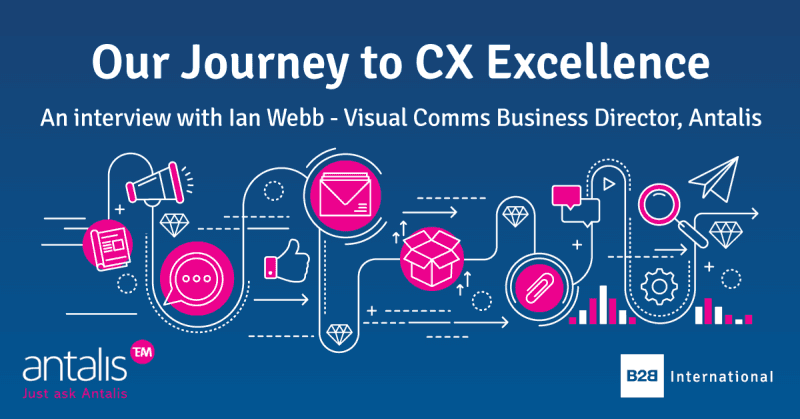
Find more examples, case studies and stories in our latest book
Having conducted hundreds of customer satisfaction and loyalty surveys over the last 20 years, we know first-hand what it takes to deliver CX excellence in b2b markets. Unfortunately, exceptional customer experiences are not as common as they should be, and it is this that drove us to write ‘B2B Customer Experience – A Practical Guide To Delivering Exceptional CX’.
The book is out now and is available to buy here. To celebrate the launch of the book we will be sharing a selection of different interviews with CX professionals, each talking about their own journey towards CX excellence. The fourth of which, with Antalis’ Ian Webb, is below.

Ian Webb, Visual Communications Business Director and Marketing Director, Antalis
What does customer experience mean to Antalis and how did your CX journey start?
Customer experience is all about satisfying the needs of your customers but of course, not everyone’s needs are the same.
Customer experience was picked up quite a number of years ago as a major topic. Antalis had created a huge number of services that customers could buy into. For example, customers could specifically ask for a timeslot, even for small orders, and people could even buy a split pallet of products.
Customer service has always been at the heart of what we do at Antalis, but when I joined the company I asked myself, “are the needs of people exactly the same or is there a segmentation into different groups?”

We commissioned B2B International to research the needs of our customers and identify whether there were any segmentation of needs, and then what value propositions could we build against each of those. It has gone from a fairly elementary list of services that people could buy into to now the starting point of a sophisticated needs-based segmentation. We did the work in France, Germany and the UK. The outputs identified three distinctive customer need groups in a very clear segmentation.
“We commissioned B2B International to research the needs of our customers and identify whether there were any segmentation of needs, and then what value propositions could we build against each of those.”
We know that anybody can buy products at specific prices – but it is hard to replicate the level of service we offer. We’re developing a whole series of support for our segmented value propositions, and will continue to add to that and develop even more tailored approaches for our customers.
How do you go about measuring the experience you deliver to your customers?
We do a global customer satisfaction survey which gets carried out every couple of years. We also have a much more regular local customer satisfaction survey. For every lost customer (someone who hasn’t dealt with us for a number of months) we ask them for feedback on an ongoing basis.
We report NPS, customer feedback and customer churn internally. We split this in the different product areas, packaging, paper etc. NPS we review on an annual basis, and customer churn is monitored weekly. We do all the standard logistics things such as OTIF on a daily basis.
Of course, we report everything at board level but we also have more regular meetings between multi-function teams including sales, logistics, procurement and marketing where we feedback key metrics, what is happening and resulting action plans.

What difficulties have you faced in embedding the segmentation within Antalis?
From the research it is very easy to see what the needs are in the different segments. The difficulty is in the implementation of it because it affects every aspect of the business. If we take timeslot delivery for example – if you place your order before 6:00 PM you get the delivery first thing next day. However some customers want a specific timeslot. The implications of that from a number of warehouses across the UK with thousands of deliveries every day with different products in different places with customers of different sizes is really difficult when you have a 5:30 to 6:00 PM cut-off the day before to deliver at 9 AM the next morning. IT are involved, customer service are involved, marketing are involved and procurement are also involved. You’ve got to tell the story to lots of different people and then get the process orientation to make sure it flows through to the customers so you get a really easy experience for the customer.
“From the research it is very easy to see what the needs are in the different segments. The difficulty is in the implementation of it because it affects every aspect of the business.”
I haven’t faced any resistance to understanding the need to move forward on customer experience – once you tell the story. The issue is in implementation. Service involves every element of the business, and so much resource, to get changes embedded and achieve a really easy customer experience.
As Marketing Director for Antalis, what is your role specific to customer experience?
I think one of the key roles of marketing is to drive alignment between departments. If marketing is right at the forefront of customer understanding it should also be the driver to ensure that we get the value proposition to work, whether that’s the resource for IT or sales or procurement, it doesn’t matter, marketing should just be the driver of change and strategic direction.
“I think one of the key roles of marketing is to drive alignment between departments.”
If marketing is seen as a passive support function for sales then it will get ignored and therefore not get the improved customer experience that you really need. If marketing is seen to become a strategic driver of the organisation, then you can get different structures and different parts of the organisation to align behind that drive. When I think about who we recruit, being customer-focused and having the right attitude is a key thing we look for. Can the individual influence and help get alignment on the ‘customer first’ strategy we want to embed throughout the whole of the company?
It starts with the sales director and the marketing director having a very close alignment. They need to have a clear view of what our values are and how this aligns with customer needs. I’d expect our tonality and our language to be the same even if we are not in the same room together. If you get a misalignment you don’t get the customer-focus you want.
What advice would you give to others who are starting out on their journey to deliver a world class customer experience?
First of all, you’ve got to really understand the needs of your customers and then get the right people in your organisation to drive the change. Therefore, HR and recruitment are a key component.
Specific to understanding the customer intimately, we’ve used customer journey mapping a lot. We have quite a long customer journey from initial prospection through to acquisition, on-boarding, ordering products, interaction with our drivers through to the customer service back-end.

We have broken that down. We’ve gone through the customer journey, highlighted the pain points and then split off into little fast action groups to go and optimise what we do. We sorted a number of those problems that will feed up to solve the whole challenge. It’s about breaking it down into bite size chunks and we using the customer journey map to do that. For example how fast can we set up a credit account? It was recognised as a pain point for the customer and so we looked into it and changed our processes so that we can now sort credit accounts out in 24 hours.
We’ve improved a number of things already as we’ve gone through the process. We’ve not had to wait for a grand launch. We just improve them as we’ve gone on. It’s important that big companies don’t get stuck in waiting for everything to be ready. You can do a lot of smaller incremental enhancements that needn’t necessarily take months or weeks to do. It can just take a matter of hours to get it sorted. These small changes matter to the customer, and add up to a customer experience that we believe is second to none.
Readers of this article also viewed:
- Our Journey to CX Excellence: an Interview with… Jo Ormrod, Coveris
- Our Journey to CX Excellence: an Interview with… David Ward, Yodel
- Our Journey to CX Excellence: an Interview with… Carol Sheppard, Molson Coors
- Go Beyond In Customer Experience – A Conversation With Chris Daffy
- Differentiating An Undifferentiated Product – A Conversation With Dale Grinstead


